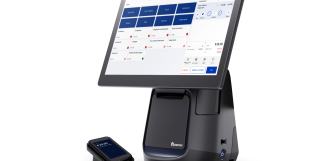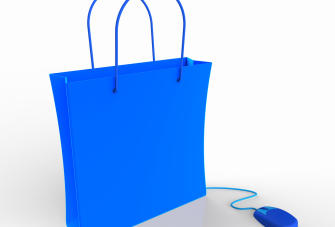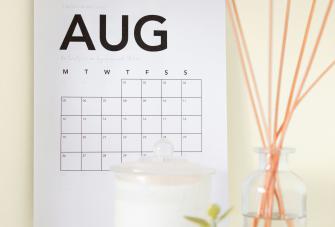What is Point of Sale Advertising?
The global point of sale market size is set to grow from $33.41 billion in 2024 to over $110 billion by 2032. Yep, that’s a massive jump. But, while loads of businesses are pouring money into these shiny systems, most aren’t actually using them to their full potential.
Sure, POS systems can help with payments via payment processing services. They can ring up your orders (Shocker, right?). You probably even know you can integrate apps, things like loyalty programs, delivery, online ordering, accounting, the whole package. There’s another big opportunity most people are sleeping on, though, and that's point-of-sale advertising.
Believe it or not, your POS system can encourage consumers right at the checkout counter. It can also help your sales by boosting impulse purchase decisions through displays so eye-catching customers can’t help but grab that extra snack, bottle of wine, or those seasonal items they didn’t even know they needed five minutes ago.
So yeah, your POS is not just a register. It’s prime selling space, and if you’re not using it? You’re literally leaving money on the counter. So let's talk about ways to make use of that space.
What is point of sale advertising?
It’s a type of purchase advertising that happens right at the point of purchase, the checkout counter, the cash register, or even in other particularly high-traffic areas of your store.
The goal here is to increase sales by driving those last-minute, unplanned buys we all know too well. Yep, the classic impulse purchases.
Merchandising is just about how products look on the shelves. But POS advertising uses POS displays and POP materials to influence real-time buying decisions and catch customers’ attention right when it matters most.
So what does that look like in real life?
- It’s the branded display stands by the door.
- It’s the free-standing displays at the aisle ends.
- It’s the in-store displays and POP and POS displays crowding the checkout counter.
- Even the printed materials, those posters, shelf signs that highlight targeted promotions.
Of course, we can’t forget digital displays. Screens at retail stores, QR codes, and interactive add-ons linked to point of sale systems. These tools help engage customers, shape purchase decisions, and make those attractive displays even harder to walk past.
For retail businesses (from grocery stores to fancy boutiques), POS advertising is one of the simplest yet most effective retail marketing strategies to attract customers, guide them through your store layout, and encourage consumers to spend more at your brilliant store.
POS advertising vs POP advertising
POS advertising happens right at the checkout.
POP advertising, on the other hand, can pop up anywhere in the store - aisle ends, free-standing displays, posters.
It’s meant to grab customers’ attention and get them to notice promos before they even reach the checkout.
Why POS advertising matters for retail businesses
Here are the perks of point of sale advertising:
Capturing impulse purchases in high-traffic areas
Around 52% of shoppers say they’ve bought something unplanned after seeing in-store ads. POS displays placed in busy aisles or near entrances grab attention as people walk by.
Big, bold, eye-catching signage or free-standing displays make products really hard to ignore.
Influencing buying decisions at checkout counters
Social media, online ads, both proven to be super effective for getting people to buy from you. You see an influencer you love wearing a product, and you want it too. But did you know that only 18% of purchase decisions actually happen online.
That means 82% of buying decisions happen in-store. Right there, at the checkout counter, people are already committed to buying something.
By showing the right product, in the right place, at the right time, you can nudge a customer to grab one more item while they’re waiting to pay.
Boosting sales with attractive displays and smart placement
Ever wonder why some products just jump out at you in a store? It’s not random. Placement matters. Products placed at eye level are 82% more likely to be bought.
That’s because people naturally notice what’s easiest to see. POS advertising takes advantage of this.
It’s simple: make it visible, make it appealing, and people are more likely to grab it.
Enhancing customer engagement in physical stores
People don’t just buy; there are many steps before they reach that point. Your customers notice, interact, and respond. POS advertising grabs attention and keeps customers looking, gently pushing them each step of the way.
Printed materials are still super effective. Posters, shelf talkers, and floor stickers are easy to spot, quick to read, and guide shoppers to deals. They make promotions obvious without being too pushy.
Digital displays, on the other hand, bring movement and flexibility. Screens can rotate messages, show demos, or even interact with a QR code.
The best results happen when you mix both. A poster highlighting a deal with a small digital screen showing the product in action. That combo keeps customers engaged, influences purchase decisions, and makes your store feel more dynamic.
Types of POS advertising strategies
Now that we know why POS advertising matters, let’s talk about the different ways you can do it. There are a bunch of tactics for both POS advertising and point of purchase advertising:
Traditional in-store displays
Basically, the old-school stuff that still works like a charm. You put products where people can see them and sales happen.
- Free-standing displays
- Endcaps
- Branded display stands
- Dump bins
- Shelf talkers
Printed POS materials
Yep, paper is still a hero. Posters, signs, and little handouts that make people notice your deals.
- Posters and signs
- Loyalty punch cards
- Instant coupons
- Contests on receipts
Digital and interactive displays
Screens, touch-screens, QR codes—basically, the flashy stuff that makes people stop and look.
- Digital signage
- Touch-screen displays
- Mobile payment prompts
- QR codes
- Recommendation engines at POS
Innovative & experiential tactics
The “wow” factor. Stuff people want to interact with or take pictures of.
- Cardboard standees
- AR mirrors
- Interactive kiosks
- Sampling stations
- Seasonal themes
Case examples & real-world use cases
Let’s look at three real-life examples of POS advertising done right.
Eye-catching displays
Humans are visual creatures. A bright pyramid of soda cans or a neatly stacked pile of books is designed to draw your attention.
Lush Cosmetics is a pro at bold, colorful in-store displays. Bath bombs piled high like produce? Check. Rainbow-colored soaps and skincare products? Double check. As soon as you walk in, your eyes are on the products.
Strategic product placement
Location matters. High-traffic areas and checkout counters are prime real estate for POS advertising.
For instance, IKEA guides you along a set path through their showroom. Along the way, small, inexpensive items (like candles, napkins, or kitchen gadgets) are strategically placed within reach. You’re already walking past them, and suddenly, they’re in your cart. Genius.
Limited-time offers
Nothing sparks urgency like a deadline. Limited-time offers push customers to buy now rather than later.
Seasonal drinks like the Pumpkin Spice Latte or Peppermint Mocha aren’t around at Starbucks all year. That scarcity makes people rush in to get their fix, creating buzz and boosting sales before the offer disappears.
Simply superior POS software
Our point of sale (POS) software is built for growing businesses. Fulfill all your point of sale needs and transform your business with a quality point of sale system from Epos Now.
Designing effective POS advertising
It's time to put everything you know about this kind of advertising into practice. Here are the POS marketing strategies that'll actually get people buying.
Use of visual appeal to engage customers
Look, people buy with their eyes first. Make it pop.
Colors that grab attention:
Think Starbucks Mermaid green, instantly catches your eye in a sea of muted shelves.
McDonald’s M red and yellow. Bright, bold, and basically screams “look at me!”
Target's red stops shoppers in their tracks
Branding that’s instantly recognizable:
Your logo or brand icon should be the first thing customers see.
The Nike swoosh, Apple apple, or LEGO block, even from a distance, people know exactly what it is.
Eye-level placement so it’s impossible to miss:
People naturally look straight ahead when walking down aisles.
Eye-level shelves for small snacks or trending items work wonders.
Big brands do this all the time. Pepsi and Lay’s chips are always in that perfect zone so shoppers can’t help but grab them.
Aligning POS with store layout & traffic flow
Where you put your displays matters as much as what’s on them.
- High-traffic areas near checkout
- Free-standing displays at aisle ends
- Make it easy for people to notice without blocking the way
Timing & theming for relevance
People respond to what’s happening now. Seasonal and trending moments make your POS advertising feel timely. Think about it:
- Back to school: perfect time to push backpacks, stationery, or lunchbox bundles.
- Summer heatwave: ice-cold drinks and sunscreen by the checkout counter.
- Valentine’s Day: heart-shaped chocolates right where couples can’t miss them.
- Big Netflix or pop culture moments: if everyone’s watching a hit show, you can theme displays around it (even something cheeky like snacks for “binge nights”).
The point is, tie your POS displays to what people are already thinking about. It makes your promotions feel natural, and it nudges customers into those “oh yeah, I totally need that” purchases.
Blending digital with physical POS elements
Don’t just stick to one or the other. Make them work together.
- QR codes on printed displays → scan it, get a discount, or see a quick product demo.
- Mobile wallet offers → tap your phone, claim the deal, and feel like a VIP while waiting at checkout.
- Integrated digital signage → show rotating promos, videos, or interactive suggestions right next to a physical display.
When you combine these, you create a dynamic experience. Printed materials grab attention, digital makes it interactive. Together, they guide purchase decisions and keep shoppers engaged.
Ensuring accessibility for impulse decision making
If you want someone to act in the moment, make it easy. No hunting, no confusion.
Here's how:
- Quick reads: short, snappy messages that people can digest in a few seconds.
- Clear CTAs: “Grab yours now,” “Scan to save,” “Add to basket”
- Strategic placement in the checkout zone → right where customers are waiting, ready to make that final impulse purchase.
You essentially want the decision to be so fast, so obvious, so unbelievably irresistible they wouldn't think twice about not buying.
Best practices for POS advertising success
You’ve got your displays, your QR codes, your digital screens, but how do you make sure they actually work? Here’s the lowdown:
- Keep displays fresh: Nobody wants to see the same boring poster every month. Switch it up, rotate products, and add seasonal themes to keep things new and exciting.
- Test multiple tactics: Try different types of POS displays, printed materials, and digital elements. See what grabs attention, what nudges those impulse purchases, and what flops.
- Measure ROI: Track sales, retail KPIs, redemption of coupons, and engagement with QR codes. Numbers don’t lie so figure out what’s really working.
- Train staff to support POS efforts: Your team is the frontline. If they know the promotions, can answer questions, and can upsell naturally.
Implementing POS advertising with Epos Now
Last but definitely not least, let's show you exactly how our retail point of sale system can make all this POS advertising bigger and better.
Tracking sales & measuring performance
The system lets you see what’s working in real time. Track uplift in impulse sales, coupon redemptions, QR code scans, and loyalty card usage. Basically, you get the data to prove your POS advertising actually works.
Testing & optimization
Once you have this data, the fun part begins. You can A/B test different display designs or locations, see which ones grab the most attention, and tweak as you go.
Scalability for multi-store operations
Our systems are cloud-based meaning that they're built for scale.
That means whether you’ve got one store or fifty, you can keep your branding uniform, run promotions across all locations, and even make localized tweaks for each store.
Your POS advertising strategy stays consistent, looks polished everywhere, and still feels relevant to each location.
Summary & next steps
That's it from us. We hope you've finished the guide with a ton of handy tips and tricks to start your own POS advertising at your store.
- Combine traditional and digital displays
- Place products smartly
- Use timing and theming
- Measure, test, and optimize
- Train your staff
Do this, and your POS will be a money-making, attention-grabbing hotspot that keeps customers engaged and sales rolling in.
FAQs
- What is point of sale advertising and why is it important?
-
It’s advertising placed right at the checkout or point of purchase.
- How does POS marketing influence impulse purchases at the checkout?
-
By showing eye-catching displays, promotions, or offers when customers are already ready to buy, nudging them to grab extra items.
- How can digital displays and QR codes enhance point of sale marketing?
-
They make promotions interactive, dynamic, and easy to act on, keeping customers engaged and driving more sales.
- What role do loyalty cards and instant coupons play in POS advertising?
-
They encourage repeat purchases and make customers feel rewarded for buying more right at checkout.
- What are some creative POS marketing strategies for physical retail stores?
-
Think branded display stands, interactive kiosks, AR mirrors, seasonal themes, and fun in-store demos or sampling stations.




